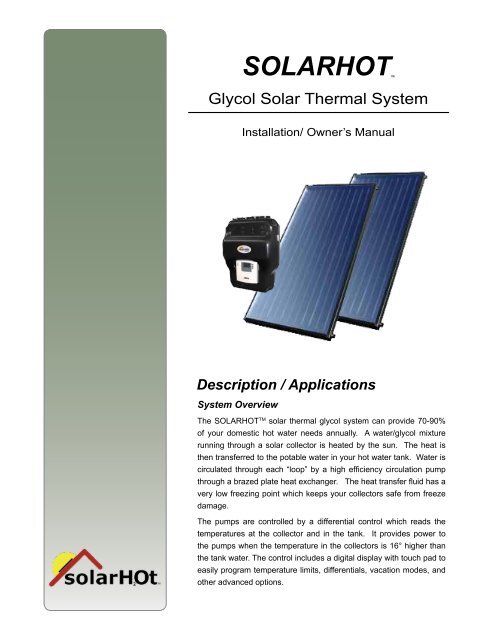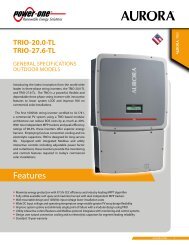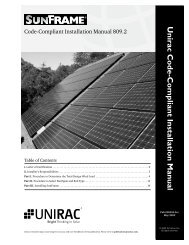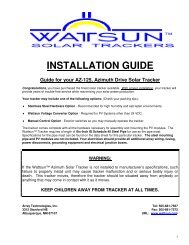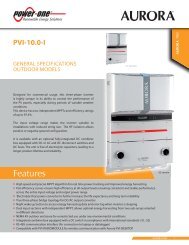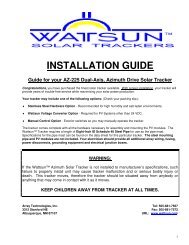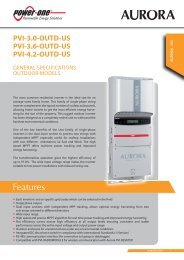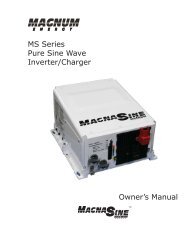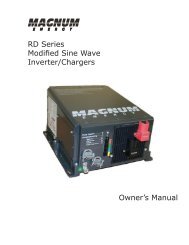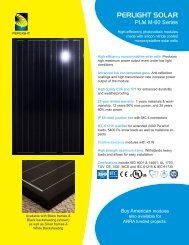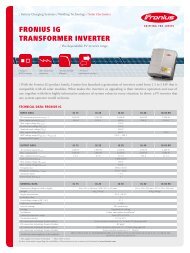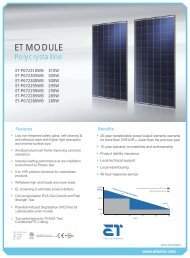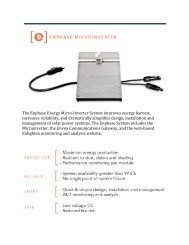SolarHot Glycol System Manual - Solar Solutions & Distribution, LLC
SolarHot Glycol System Manual - Solar Solutions & Distribution, LLC
SolarHot Glycol System Manual - Solar Solutions & Distribution, LLC
You also want an ePaper? Increase the reach of your titles
YUMPU automatically turns print PDFs into web optimized ePapers that Google loves.
SOLARHOT<br />
<strong>Glycol</strong> <strong>Solar</strong> Thermal <strong>System</strong><br />
Installation/ Owner’s <strong>Manual</strong><br />
Description / Applications<br />
<strong>System</strong> Overview<br />
The SOLARHOT TM solar thermal glycol system can provide 70-90%<br />
of your domestic hot water needs annually. A water/glycol mixture<br />
running through a solar collector is heated by the sun. The heat is<br />
then transferred to the potable water in your hot water tank. Water is<br />
circulated through each “loop” by a high efficiency circulation pump<br />
through a brazed plate heat exchanger. The heat transfer fluid has a<br />
very low freezing point which keeps your collectors safe from freeze<br />
damage.<br />
The pumps are controlled by a differential control which reads the<br />
temperatures at the collector and in the tank. It provides power to<br />
the pumps when the temperature in the collectors is 16° higher than<br />
the tank water. The control includes a digital display with touch pad to<br />
easily program temperature limits, differentials, vacation modes, and<br />
other advanced options.
Contents<br />
Features....................................................................................................................3<br />
<strong><strong>Solar</strong>Hot</strong> <strong>Glycol</strong> Advantage............................................................................................................................ 3<br />
Safety............................................................................................................................................................. 3<br />
Certification.................................................................................................................................................... 3<br />
Materials List...........................................................................................................4<br />
GS_P <strong>Glycol</strong> <strong>System</strong>.................................................................................................................................... 4<br />
GS_P_RM <strong>Glycol</strong> <strong>System</strong> with Adjustable Mount Hardware........................................................................ 4<br />
Additional Materials Required........................................................................................................................ 5<br />
<strong>Glycol</strong> <strong>System</strong> Specifications...................................................................................5<br />
Installation................................................................................................................6<br />
Collector Orientation...................................................................................................................................... 7<br />
Installing the Collectors.................................................................................................................................. 8<br />
Installing the Mounting Brackets.................................................................................................................... 8<br />
Preparing the Collectors................................................................................................................................ 9<br />
Mounting the Collectors...............................................................................................................................10<br />
Connect to Pipes.........................................................................................................................................13<br />
Installing the Temperature Sensor...............................................................................................................14<br />
Pipe Runs....................................................................................................................................................14<br />
Installing the Tempering Valve.....................................................................................................................14<br />
Mounting the SolVelox on the Storage Tank................................................................................................15<br />
Installing the Differential Control..................................................................................................................16<br />
Check Collector Loop for Leaks...................................................................................................................18<br />
Charging the <strong>System</strong>...................................................................................................................................18<br />
Starting the <strong>System</strong>.....................................................................................................................................19<br />
Check <strong>System</strong> Operation.............................................................................................................................19<br />
• Operation ........................................................................................................19<br />
Vacation Settings ........................................................................................................................................19<br />
Emergency Shut Off....................................................................................................................................20<br />
Maintenance...........................................................................................................20<br />
Freeze Protection........................................................................................................................................20<br />
Clear Sediment from Strainer......................................................................................................................20<br />
Descaling the Heat Exchanger ...................................................................................................................20<br />
Change Heat Transfer Fluid.........................................................................................................................21<br />
Pumps..........................................................................................................................................................21<br />
Service.........................................................................................................................................................21<br />
Warranty Information.............................................................................................22<br />
Page 2 <strong><strong>Solar</strong>Hot</strong> <strong>Glycol</strong> Instructions © SOLARHOT 2009
Electrical Shock, Fire, Explosion and Burn Hazards<br />
This system must be installed, adjusted, and put into operation only by a trained, qualified professional or<br />
service agency in accordance with the National Electric Code ANSI/NFPA 70 (Canada CSA C22.1), state and local<br />
codes, and authorities having jurisdiction.<br />
The installer must carefully read and follow the installation and service instructions contained in this manual. Make<br />
them available to the equipment owner, so they can be kept for future reference.<br />
Features<br />
SOLARHOT <strong>Glycol</strong> Advantage<br />
SOLARHOT has uniquely created the SolVelox package, which pre-assembles and integrates an<br />
oversized stainless steel heat exchanger along with the pumps and valves necessary to drive a<br />
two-loop solar system. The heat exchanger and pumps are sized to meet the heat output of up to<br />
six solar collectors, so one SolVelox appliance provides an economical solution as you scale the<br />
system to meet your particular needs. Also, the Solvelox is externally mounted in order to reduce<br />
maintenance issues.<br />
Safety<br />
The best performance will come from a solar collector with aluminum sides and low iron solar glass<br />
well sealed to hold the heat. These materials weigh 80-150 lbs., depending on the size of the<br />
collector.<br />
Electrical Shock and Fall Injury Hazard.<br />
Use extreme caution when mounting collectors on a roof or when connecting any wiring or electrical hookups.<br />
○○<br />
○○<br />
○○<br />
○○<br />
○○<br />
○○<br />
○○<br />
ALWAYS use fall protection<br />
Secure all ladders on level ground<br />
Locate all possible hazards, overhead wires, loose shingles etc<br />
Make sure power is turned off before adding water to the system<br />
NEVER connect power to the water heater or storage tank until it has been filled.<br />
Use a tempering valve or mixing valve to prevent scalding<br />
Consult proper authorities and check with your local building inspector for permit requirements<br />
and local building codes before project commencement. <strong>System</strong> must meet local code<br />
requirements for penetrating structural members and fire-rate assemblies.<br />
Certification<br />
The solar energy system described by this manual, when properly installed and maintained, meets<br />
the minimum standards established by the SRCC. This certification does not imply endorsement or<br />
warranty of this product by the SRCC.<br />
<strong><strong>Solar</strong>Hot</strong> <strong>Glycol</strong> Instructions © SOLARHOT 2009 Page 3
Section: General Information<br />
Materials List<br />
GS_P or GS_S <strong>Glycol</strong> <strong>System</strong><br />
<strong>System</strong> requirements:<br />
□ □(1-6) SOLARHOT Platinum or Silver solar collectors (Platinum include 1” gasketed<br />
unions)<br />
□ □(1) SOLARHOT SolVelox glycol pump package (pumps, heat exchanger with<br />
Elastomeric insulation, Steca differential control), including mounting bracket, six (6)<br />
screws, two (2) sensors (third sensor optional), strain reliefs for sensors, and 50 ft.<br />
sensor wire<br />
□ □(1) minimum 2 gal. expansion tank, (flex line and mounting bracket optional)<br />
□ □(1) Flush mount hardware kit per collector<br />
□ □(1) <strong>Solar</strong> Dip tube<br />
□ □(1) ASSE 1017 certified mixing / anti-scald valve<br />
□ □(1) Roof kit per collector array (flashing, caps, plug, reducing elbows)<br />
(1) 1/2” copper roof flashing with special adapter cap<br />
(1) 1/2” copper roof flashing with gooseneck<br />
(1) Row Kit (for Platinum collectors, Silver collectors add (2) gasketed unions per<br />
collector or copper couplings and caps)<br />
(2) 1”x1/2” elbows<br />
GS_P_RM or GS_S_RM <strong>Glycol</strong> <strong>System</strong> with Adjustable Mount Hardware<br />
<strong>System</strong> requirements:<br />
□ □(1-6) SOLARHOT Platinum or Silver solar collectors (Platinum include 1” gasketed<br />
unions)<br />
□ □(1) SOLARHOT SolVelox glycol pump package (pumps, heat exchanger with Elastomeric<br />
insulation, Steca differential control), including mounting bracket, six (6) screws,<br />
two (2) sensors (third sensor optional), strain reliefs for sensors, and 50 ft. sensor wire<br />
□ □(1) minimum 2 gal. expansion tank, (flexible line and mounting bracket optional)<br />
□ □(1) Adjustable mount hardware kit per collector (telescoping legs to vary mounting<br />
angle)<br />
□ □(1) Adjustable mount hardware kit per array<br />
□ □(1) <strong>Solar</strong> Dip tube<br />
□ □(1) ASSE 1017 certified mixing/ anti-scald valve<br />
□ □(1) Roof kit per collector array (flashing, caps, plug, reducing elbows)<br />
(1) 1/2” copper roof flashing with special adapter cap<br />
(1) 1/2” copper roof flashing with gooseneck<br />
(1) Row Kit (for Platinum collectors, Silver collectors add (2) gasketed unions per<br />
collector or copper couplings and caps)<br />
(2) 1”x1/2” elbows<br />
Page 4 <strong><strong>Solar</strong>Hot</strong> <strong>Glycol</strong> Instructions © SOLARHOT 2009
Section: General Information<br />
Additional Materials Required<br />
□ □ Electric water heater to use for solar storage tank, 80 gal. minimum<br />
□ □ 1/2” copper or stainless steel tubing and standard fittings<br />
*****************Do NOT use PEX, PVC or other plastic piping ***************<br />
□ □ Mounting hardware<br />
□ □ 1” elastomeric insulation (e.g. Nomaco K-Flex LS)<br />
□ □ PVC insulation jacketing (e.g. Speedline Smoke Free PVC)<br />
□ □ Vinyl tape<br />
□ □ 40% GRAS propylene glycol heat transfer solution<br />
□ □ Drip pan (optional, see Installation Diagram)<br />
<strong>Glycol</strong> <strong>System</strong> Specifications<br />
GS_P and GS_P_RM<br />
Congratulations on the installation of your SOLARHOT <strong>System</strong>! Correctly installed and maintained,<br />
your system should provide you with many years of uninterrupted solar hot water. The solar collectors<br />
are designed to last 25-35 years, electric water heaters 10-20 years, and pumps, controls, and<br />
valves 5-10 years. Local water quality and usage will greatly affect life expectancies.<br />
<strong>Solar</strong> Collector: (Recommended)<br />
SOLARHOT Platinum or Silver flatplate collectors<br />
<strong>Solar</strong> Storage Tank (80 gal. minimum), not included:<br />
Whirlpool EE3Z80HD055V<br />
American Premier E62-80H-045DV<br />
Rheem 81VR80TC-1<br />
Lochinvar FTA082K<br />
Pumps:<br />
Collector Loop <strong>Glycol</strong>: Wilo Star 16<br />
Tank Loop: Wilo Star 8B<br />
Controller:<br />
Differential Control TR 0301U, includes two (2) (third sensor optional) PT1000 sensors, one is<br />
prewired<br />
Heat Exchanger:<br />
<strong><strong>Solar</strong>Hot</strong> P-HX-210512<br />
<strong>System</strong> operating parameters:<br />
Pressure on a glycol system should be between 25-30 psi<br />
Flow meter should read about 5 gpm on the collector loop and 3.5 on the tank loop<br />
<strong><strong>Solar</strong>Hot</strong> <strong>Glycol</strong> Instructions © SOLARHOT 2009 Page 5
Section: Installation<br />
Installation<br />
Refer to Figure 1 for the relative location of the pipes, collectors, and SolVelox pump package.<br />
The cold water supply line to the solar storage tank must be covered with a minimum of 7/8” x 1/2”<br />
insulation for 5 feet from the water heater. Please note that if the water storage tanks are located<br />
in or above living spaces, a drip pan with a drain line to the outside of the building is required.<br />
Figure 1 - Installation Diagram<br />
Notes:<br />
◦◦<br />
The pipe, heat exchanger, expansion tank, and pump size will be determined by the size of the collector array.<br />
◦◦<br />
All pipes 1/2” diameter minimum. DO NOT USE PLASTIC PIPES!<br />
◦◦<br />
An expansion tank should be installed on the potable water side for systems that do not allow backflow.<br />
◦◦<br />
Refer to manufacturer’s instructions regarding installation of the tempering valve.<br />
Page 6 <strong><strong>Solar</strong>Hot</strong> <strong>Glycol</strong> Instructions © SOLARHOT 2009
Section: Installation<br />
There are two basic methods for mounting<br />
collectors on the roof or ground, as outlined in<br />
Figure 2.<br />
1. Flush Mount– This is the most common<br />
method. If the existing roof line is not<br />
suitable for any reason, the adjustable<br />
mount may be employed.<br />
2. Adjustable Mount– This is sometimes<br />
required on a flat roof or in the case of a<br />
ground mount to optimize available solar<br />
energy.<br />
Figure 2 - Mounting Options<br />
Flush Mount:<br />
Adjustable Mount:<br />
Collector Orientation<br />
The collectors should be mounted as close to<br />
due south as is reasonable, considering the roof<br />
line. However, if the collector is mounted within<br />
45 degrees of south any performance drop is<br />
insignificant. The aesthetics of flush mounting<br />
a collector on the roof will generally outweigh<br />
performance improvements less than 5%.<br />
The collectors should ideally be inclined at the<br />
same angle as the latitude, i.e. if you are located<br />
in Raleigh, NC (latitude 38 degrees) you would<br />
ideally have the collectors inclined 38° from<br />
horizontal. Testing has shown that mounting a<br />
collector within ±15° of the site’s latitude will lead<br />
to no significant degradation in the collector’s<br />
annual performance.<br />
Pay close attention to the angle and direction<br />
of the roof line. If your roof line doesn’t match<br />
the ideal criteria listed above, we recommend<br />
adding collector area as opposed to mounting<br />
the collector at a tilt. For example: If your<br />
roof faces the southeast, you may use three<br />
collectors instead of the two collectors which<br />
would be typical for a family of four.<br />
Further, minimize the shade over the collectors.<br />
Collectors should receive 6-8 hours of direct<br />
sunlight each day for optimal performance.<br />
Do not use plastic piping<br />
PEX, PVC and other forms of non-metal pipes will<br />
burst at solar temperatures. Only use correctly<br />
sized copper or stainless steel pipes in solar heating<br />
system on both the solar and potable water loops.<br />
All connections to and from the SOLVELOX must be<br />
copper or stainless steel.<br />
<strong><strong>Solar</strong>Hot</strong> <strong>Glycol</strong> Instructions © SOLARHOT 2009 Page 7
Section: Installation<br />
Installing the Collectors<br />
Fall Injury Hazard.<br />
Figure 3 - Spacing<br />
Prepare the roof to work safely, employing roof<br />
scaffolding methods approved by OSHA.<br />
Unfortunately there are no stud finders for<br />
rooftops, but it is important to mount the<br />
collectors into the rafters. Here are a couple of<br />
ideas for how to locate a rafter:<br />
○○<br />
○○<br />
○○<br />
○○<br />
From inside the attic, drill an angled hole<br />
from the intersection of the roof deck and<br />
the rafter at a 45° angle into the roof deck<br />
from the intersection. The spot where<br />
the drill first penetrates the roof should be<br />
approximately the center of the rafter.<br />
From the attic, measure the distance from<br />
an existing roof protrusion to the nearest<br />
rafter. Use that same measurement on the<br />
outside of the roof.<br />
Drill from the outside of the roof. Measure<br />
from the attic side of the hole to the nearest<br />
rafter. Use the same dimensions of the<br />
outside.<br />
Using a 3/16” x 12” long drill bit, drill from<br />
the inside of the house through the rafter to<br />
the outside.<br />
Installing the Mounting Brackets<br />
1. Mark a 10’ long horizontal line at least 18”<br />
below the peak of the roof.<br />
2. Measure 97½“ down from the first horizontal<br />
line and mark another 10’ line as shown in<br />
Figure 3.<br />
3. Locate the center of a rafter and mark<br />
vertically along the rafter with a chalk line<br />
between the two horizontal lines.<br />
4. Using the rafter spacing, make vertical<br />
marks over the center of the rafters, marking<br />
all the rafters that the collectors will span.<br />
5. Using the mounting foot as a template,<br />
hold the mounting foot at the center of<br />
each intersection. Holding the foot at the<br />
intersection of the chalk lines, mark the<br />
holes with a marker. Repeat this procedure<br />
until each of the mounting foot locations<br />
have been marked. (four mounting feet for<br />
each collector)<br />
6. With a 3/16” bit, drill a pilot hole at each one<br />
of the marks you just made.<br />
7. Place the mounting feet over the pilot holes.<br />
Screw the brackets to the rafters using<br />
3/8” x 2 1/2” stainless steel lag screws, flat<br />
washers, and lock washers as in Figure 4a<br />
or 4b.<br />
Page 8 <strong><strong>Solar</strong>Hot</strong> <strong>Glycol</strong> Instructions © SOLARHOT 2009
Section: Installation<br />
Figure 4a - Flat Mount Shown<br />
Preparing the Collectors<br />
Burn hazard<br />
When working with the solar collectors, cover the<br />
panels until installation is complete. Both the panels<br />
and unions quickly begin to collect heat and pose a burn<br />
hazard.<br />
Figure 4b - Adjustable Mount Shown<br />
The end of the collectors with the SOLARHOT<br />
name plate should be installed closest to the<br />
ridge of the roof, as there are weep holes to<br />
release condensation on the other end. The<br />
corners of the collectors will have 1” unions<br />
preinstalled. These will be mounted with elbows<br />
as in Figure 5a. Depending on system flow<br />
configuration, the two ends not in use will have<br />
end caps as in Figure 5b.<br />
Figure 5a - Collector Configuration<br />
Figure 5b - Collector Configuration<br />
<strong><strong>Solar</strong>Hot</strong> <strong>Glycol</strong> Instructions © SOLARHOT 2009 Page 9
Section: Installation<br />
Mounting the Collectors<br />
Refer to Figure 7 for proper installation.<br />
Figure 7a: Flush Mount<br />
ROOF FRAMING<br />
MEMBERS<br />
COLLECTOR<br />
MOUNTING<br />
FOOT<br />
SEE DETAIL<br />
SECTION A-A<br />
INCLINED ROOF<br />
NOTES:<br />
1. 4 FEET PER COLLECTOR AS SHOWN.<br />
2. FEET ARE TO BE LOCATED ABOVE FRAMING BEAM OR RAFTER.<br />
3/8" STAINLESS STEEL<br />
BOLT w/LOCKWASHER<br />
& FLAT WASHER<br />
MOUNTING CLIP<br />
STAINLESS STEEL<br />
SLIDING NUT<br />
4" LENGTH ALUMINUM<br />
CHANNEL FOOT<br />
3/8 FLAT WASHERS<br />
SECTION A-A<br />
SOLAR COLLECTOR<br />
MOUNTING GROOVE<br />
Roofing Materials<br />
on Framing <strong>System</strong><br />
Beam or Rafter<br />
3/8" BOLT<br />
3/8 STAINLESS STEEL LAG SCREWS 2-1/2"<br />
LENGTH OR GREATER SET IN SEALANT.<br />
(DRILL PILOT HOLE 3/4 OF BOLT DIA.)<br />
3/8" LOCK WASHER<br />
3/8" FLAT WASHER<br />
LOCKSTRAP<br />
S-NUT<br />
3/8" x 3" LAG SCREWS<br />
3/8" FLAT WASHER<br />
COLLECTOR LOCK<br />
COMPONENTS<br />
COLLECTOR<br />
4" LENGTH ALUMINUM<br />
MOUNT FOOT<br />
COLLECTOR MOUNT<br />
DETAILS<br />
4 FEET PER COLLECTOR<br />
Page 10 <strong><strong>Solar</strong>Hot</strong> <strong>Glycol</strong> Instructions © SOLARHOT 2009
Figure 7b: Adjustable Mount<br />
UPPER TELESCOPING LEG<br />
SWING MOUNT<br />
SEE DETAIL A<br />
45°<br />
UPPER TELESCOPING<br />
LEG - 38" LENGTH<br />
LOWER TELESCOPING<br />
LEG - 36" LENGTH<br />
LOWER MOUNT<br />
SEE DETAIL C<br />
UPPER MOUNT SEE DETAIL B<br />
3/8" BOLT<br />
COLLECTOR<br />
LOCK<br />
3/8" LOCK WASHER<br />
3/8" FLAT WASHER<br />
LOCKSTRAP<br />
DETAIL A<br />
S-NUT<br />
ALUMINUM STRUT<br />
STRAIGHT ALUMINUM<br />
SWING MOUNT<br />
5/16" FLAT WASHER<br />
5/16" LOCK WASHER<br />
5/16" NUT<br />
5/16" FLAT WASHER<br />
2 - #10 SELF TAPPING SCREWS<br />
5/16" x 2-1/2" BOLTS<br />
UPPER ALUMINUM TELESCOPING LEG<br />
LOWER ALUMINUM TELESCOPING LEG<br />
DETAIL B<br />
5/16" FLAT WASHER<br />
5/16" LOCK WASHER<br />
5/16" NUT<br />
3/8" x 3" LAG SCREWS<br />
3/8" FLAT WASHER<br />
8" ALUMINUM FOOT<br />
5/16" FLAT WASHER<br />
5/16" x 2-1/2" BOLT<br />
DETAIL C<br />
ANGLED ALUMINUM<br />
SWING MOUNT<br />
5/16" FLAT WASHER<br />
5/16" LOCK WASHER<br />
5/16" NUT<br />
3 - #10 SELF TAPPING SCREWS<br />
3/8" x 3" LAG SCREWS<br />
3/8" FLAT WASHER<br />
5/16 x 2-1/2" BOLT<br />
<strong><strong>Solar</strong>Hot</strong> <strong>Glycol</strong> Instructions © SOLARHOT 2009 5/16" FLAT WASHER<br />
8" ALUMINUM FOOT<br />
Page 11
Section: Installation<br />
Figure 8a: Mounting Clips for Flush Mount<br />
Figure 8b: Mounting Clips for Adjustable Mount<br />
1. The mounting clip is made up of two parts<br />
joined by a stainless steel bolt with lock<br />
washer as in Figure 8a and b. Before<br />
taking the collectors up to the roof, slide the<br />
stainless steel sliding nut into the anodized<br />
aluminum channel foot. Now carefully place<br />
the first collector so that the mounting clip<br />
fits in the mounting groove that runs around<br />
the bottom edge of the collector and tighten<br />
Figure 9: Joining Collectors<br />
the bolt. Ensure that the clips are installed<br />
securely.<br />
2. Mount the next collector so that the<br />
unions join to the first collector and<br />
secure the mounting clips as in Figure 9.<br />
Connect to Pipes<br />
1. Using a wood bit the same size as your<br />
pipes, drill a hole in the center of a shingle<br />
below where the bottom corner of the<br />
collector inlet will be and in the opposite<br />
corner, where the collector outlet will be.<br />
2. Apply sealant to the underside of the copper<br />
flashing. Carefully raise the drilled shingle,<br />
place flashing underneath and insert collar<br />
through the hole as shown in Figure 10.<br />
3. Run pipes from attic through the copper<br />
flashing and sweat connect them to the<br />
street elbows. See “Pipe Runs” section<br />
for specific instructions.<br />
Page 12 <strong><strong>Solar</strong>Hot</strong> <strong>Glycol</strong> Instructions © SOLARHOT 2009
Section: Installation<br />
Figure 10 - Copper Flashing<br />
Figure 11a - Sensor Installation<br />
Installing the Temperature Sensor<br />
1. Strap the PT1000 probe sensor to the<br />
copper pipe at the collector outlet using a<br />
stainless steel screw clamp as shown in<br />
Figure 11a.<br />
Figure 11b - Sensor Installation<br />
2. Feed the sensor wire through the gooseneck<br />
of the copper flashing as in Figure 11b. The<br />
flashing can then be soldered to seal it from<br />
leaks.<br />
3. For sensor to operate correctly it must be<br />
isolated from exterior conditions. All of the<br />
exposed copper, as well as the sensor<br />
itself, needs to be completely covered with<br />
insulation and UV jacketing.<br />
Pipe Runs<br />
If the water storage tanks are<br />
located in or above living spaces, a drip pan with<br />
a drain line to the outside of the building is<br />
required.<br />
Use 1/2” copper tubing or larger. All pipes should<br />
be wrapped with at least 3/4” thick insulation. We<br />
recommend 1” Elastomeric insulation. Outdoor<br />
pipes should also be jacketed with UV protection<br />
material or some other means to protect it from<br />
moisture and ultraviolet deterioration. We<br />
recommend Nomaco K-Flex LS with Speedline<br />
Smoke Safe PVC Fitting Covers and vinyl tape.<br />
All pipes must be well supported or they will<br />
sag. Sagging pipes may trap water. Hanger<br />
should spread the load so that the insulation is<br />
not compressed. Place supports every 4.7 feet.<br />
Installing the Tempering Valve<br />
Refer to manufacturer’s instructions for<br />
information on installing the tempering valve.<br />
Burn and Scald Hazard<br />
Be sure to install the Watts 1170-M2 hot water<br />
temperature valve to control water temperature<br />
at a safe operating level. Carefully follow the<br />
manufacturer’s procedures for installation to ensure<br />
accurate water temperature sensing and effective<br />
control operation.<br />
<strong><strong>Solar</strong>Hot</strong> <strong>Glycol</strong> Instructions © SOLARHOT 2009 Page 13
Section: Installation<br />
Mounting the SolVelox on the Storage Tank<br />
1. Confirm that the P&T valve is on the side<br />
of the tank. If it is on the top of the tank,<br />
unscrew it and place it in the port on the<br />
side of the tank if a side port is available.<br />
2. Use needle nose pliers to remove the heat<br />
trap from the hot side of the tank and set<br />
aside.<br />
3. Feed the solar dip tube into the tank, closed<br />
end down into the port previously noted as<br />
the “hot” port until it seats.<br />
4. Lay the tank down on the ground on top of<br />
cardboard or towels.<br />
5. Place the bracket over the SolVelox and<br />
place the assembly on the side of the tank.<br />
The side of the SolVelox should be 1” to the<br />
left of the top electrode cover. The bracket<br />
should lie flat on the top of the tank. Scribe<br />
the tank to match the bracket location.<br />
6. Using two #10 - 16 x 3/4” self drilling<br />
screws, screw the top of the bracket to the<br />
top of the hot water tank. Ensure that the<br />
vertical section of the bracket above the<br />
heat exchanger is flush with the side of the<br />
tank before you drive in the screws.<br />
7. While holding the bracket and the<br />
SolVelox firmly against the tank, drive two<br />
#10-16 x 3/4” self drilling screws into the<br />
lower section of the bracket just below the<br />
heat exchanger and two screws just above<br />
the heat exchanger. It is critical that you<br />
hold the bracket and SolVelox firmly against<br />
the tank at this point otherwise it will be<br />
loose when you stand the tank upright.<br />
Seek assistance to make sure you get the<br />
product snug on the tank.<br />
8. Connect a brass tee to the cold water inlet to<br />
Figure 12 - SolVelox Piping<br />
the tank, drive four #10-16 x 3/4” self drilling<br />
screws into the bracket with two just above<br />
and two just below the heat exchanger. See<br />
Figure 12.<br />
9. Using 1/2” copper pipe or 1/2” flexible<br />
stainless steel pipe, join ball valve D of the<br />
SolVelox assembly with a tee connected to<br />
the cold inlet. This is the cold water input to<br />
the SolVelox. See Figure 13.<br />
10. Using 1/2” pipe and fittings or 1/2” MxF<br />
flexible stainless steel pipe, connect the hot<br />
water inlet (where you previously installed<br />
the solar dip tube) to ball valve C on the<br />
SolVelox. This is the hot water return to<br />
storage.<br />
11. Using the flexible stainless steel tubing,<br />
attach the expansion tank to the expansion<br />
tank port at the lowest point on the left,<br />
below the collector loop pump. Mount the<br />
expansion tank to the wall or to the storage<br />
tank. See Figure 14.<br />
Do not use plastic piping<br />
PEX, PVC and other forms of non-metal pipes will<br />
burst at solar temperatures. Only use correctly<br />
sized copper or stainless steel pipes in solar heating<br />
system on both the solar and potable water loops.<br />
All connections to and from the SOLVELOX must be<br />
copper or stainless steel.<br />
Page 14 <strong><strong>Solar</strong>Hot</strong> <strong>Glycol</strong> Instructions © SOLARHOT 2009
Section: Installation<br />
Figure 13 - <strong>Glycol</strong> Piping Diagram<br />
Pressure Gauge<br />
Install Pressure Relief Valve<br />
Embedded Check Valve<br />
Descaling Port<br />
Air Accumulator<br />
Expansion Tank Port<br />
Drain Valve<br />
Clean Out Port<br />
12. Attach a pressure relief valve to the port<br />
found at the left side of the pressure gauge.<br />
The pressure relief should point towards the<br />
ground.<br />
13. The ports A and B on the left are for the<br />
collector loop. The pipe coming from the top<br />
of the collectors carries the hot antifreeze<br />
solution and should be attached to port B.<br />
The pipe leading to the collector attaches<br />
to port A directly above the pressure gauge.<br />
Connect the collector return to the SolVelox<br />
via the second ball valve from the left.<br />
Figure 14 - Expansion Tank<br />
Installing the Differential Control<br />
Burn and Scald Hazard<br />
Excessive water temperatures could cause explosion,<br />
burns, scalding, pressure relief flooding and fitting<br />
leaks. Carefully follow the outlined procedures for<br />
temperature sensor installation to ensure accurate<br />
water temperature sensing and effective control<br />
operation.<br />
Your glycol system is automated by the<br />
differential control located on the face of the<br />
SolVelox cover, as shown in Figure 15.<br />
When installing the SolVelox pump package,<br />
consult the appliance manufacturer’s<br />
instructions for additional information on wiring,<br />
installing the three sensors, and programming<br />
the control. See also Figure 16.<br />
Do not use plastic piping<br />
PEX, PVC and other forms of non-metal pipes will<br />
burst at solar temperatures. Only use correctly<br />
sized copper or stainless steel pipes in solar heating<br />
system on both the solar and potable water loops.<br />
All connections to and from the SOLVELOX must be<br />
copper or stainless steel.<br />
<strong><strong>Solar</strong>Hot</strong> <strong>Glycol</strong> Instructions © SOLARHOT 2009 Page 15
Backup Option<br />
Optionally use a 2nd water heater to provide backup heat to the system. The tank with the SolVelox<br />
mounted to it will store the solar heated water and will not provide any back up heat. This tank will be<br />
referred to as the solar tank.<br />
Mount the SolVelox and plumb the cold water from the street to the solar tank the same as with a single<br />
tank system.<br />
Draw the hot water from the solar tank, through a tempering valve and deliver it to the second water<br />
heater’s (the backup tank) COLD IN port.<br />
Plumb the hot water from the backup tank to the house.<br />
The backup tank will work the same way as a standard water heater but when there<br />
is solar available, the tank’s thermostat will not signal the heating source to fire.<br />
Page 16 <strong><strong>Solar</strong>Hot</strong> <strong>Glycol</strong> Instructions © SOLARHOT 2009
Section: Installation<br />
Figure 15 - SolVelox Wiring<br />
Figure 16 - SolVelox Wiring Diagram<br />
1. For the first sensor, 50’ of 18 gauge<br />
sensor wire is included to reach the panel<br />
collectors. If you require more wire for your<br />
system design, use UV stable (black) 18<br />
gauge sensor wire. This sensor is denoted<br />
by T1 on the Steca display.<br />
Figure 17 - Lower Tank Sensor<br />
2. The lower tank sensor is approximately<br />
5’ long. Remove the lower access panel<br />
shown in Figure 17 and place the sensor<br />
firmly against the interior tank surface. The<br />
heavy insulation should hold it securely<br />
<strong><strong>Solar</strong>Hot</strong> <strong>Glycol</strong> Instructions © SOLARHOT 2009 Page 17
Section: Installation<br />
in place. While the panel is open, turn the<br />
bottom heating element to its lowest set<br />
point. This sensor is denoted by T2 on the<br />
Steca display.<br />
3. The short sensor wire is to be installed<br />
on the pipe returning to the backup water<br />
heater (potable water return) from the heat<br />
exchanger by using a stainless steel screw<br />
clamp (Figure 13, Port C). It should be<br />
placed on the pipe as far from the control<br />
as possible. Insulate over the sensor. This<br />
sensor is denoted by T3 on the Steca<br />
display.<br />
Check Collector Loop for Leaks<br />
1. Before system has been charged, open all<br />
shut-off valves on collector loop.<br />
2. Attach a female to male adapter to the drain<br />
valve on the bottom left of the SolVelox.<br />
3. Open drain valve and attach gas test block<br />
with pressure gauge.<br />
4. Apply 60 psi pressure for 15 minutes. Any<br />
drop in pressure during that time indicates<br />
a leak.<br />
5. Find the source of the leak and repair it.<br />
Repeat this procedure until the loop holds<br />
pressure.<br />
Charging the <strong>System</strong><br />
1. Connect the outlet of a 1HP pump via a hose<br />
to the fill valve, located below the pressure<br />
gauge on port A. Refer to Figure 13.<br />
2. Open fill valve.<br />
3. Open the drain valve, located on the bottom<br />
left corner of the SolVelox (below the pump<br />
which leads to port A).<br />
4. Connect drain valve to a bucket.<br />
5. Fill the bucket with the appropriate mixture<br />
of propylene glycol and water. (see<br />
manufacturer’s recommendation on the<br />
percentage of propylene glycol necessary<br />
for freeze protection in your area. We<br />
recommend Noble NoBurst.)<br />
6. Run pump. Initially air will vent out of the<br />
boiler drain, then a mixture of coolant and<br />
air will follow. This process may take 10-30<br />
minutes.<br />
7. Continue running the pump until you do not<br />
see air bubbles in the coolant.<br />
8. Turn off pump. Let the system sit for 2<br />
minutes.<br />
9. Discharge any air caught in the air trap<br />
using the schrader valve located below the<br />
collector pump.<br />
10. Repeat previous steps until no air is<br />
discharged.<br />
11. Close drain valve.<br />
12. Continue charging until it reaches<br />
the necessary pressure for the system’s<br />
configuration. The system requires 15 psi<br />
plus 1 psi per 2.3 vertical feet to the top of<br />
the collector.<br />
13. Close the fill valve.<br />
14. Turn off and disconnect charging pump.<br />
Page 18 <strong><strong>Solar</strong>Hot</strong> <strong>Glycol</strong> Instructions © SOLARHOT 2009
Section: Operation<br />
Operation<br />
Starting the <strong>System</strong><br />
Figure 18 - Differential Control<br />
1. Confirm that all shut-off valves are fully<br />
open.<br />
2. Turn on system and let it run for 5 minutes.<br />
3. Double-check every component and all pipe<br />
runs and fittings for leaks.<br />
4. Adjust upper element of the water heat to a<br />
maximum of 120° F for back up heat.<br />
5. Set the high limit on the control to no more<br />
than 185° F. Refer to Steca owner’s manual.<br />
Check <strong>System</strong> Operation<br />
Let the system run for 15 minutes on a sunny day,<br />
preferably around noon. Three temperatures<br />
will show on the control: the collector outlet<br />
temperature, the bottom of the tank temperature,<br />
and the temperature of the water returning to the<br />
tank. Typically you should see the temperature<br />
at the bottom of the tank vary from 60-80° F (city<br />
water temperature) to 185° (high limit set on the<br />
control) The water at the top of the tank will<br />
be typically higher than the water at the bottom,<br />
but should not exceed the high limit set on the<br />
control. The Temperature and Pressure Relief<br />
Valve on the storage tank is set to 210° F.<br />
The system will automatically turn on the pumps<br />
when the collector temperature is 16° higher<br />
than the water at the bottom of the tank. It<br />
will shut off the system when the temperature<br />
differential is 8° F. Collector temperatures may<br />
rise well above 200° F, but the system will not<br />
run beyond the high limit set on the control.<br />
A system correctly installed will show the water<br />
returning to the tank to be at least 3-10° F<br />
warmer than the water at the bottom of the tank.<br />
Please refer to the differential control owner’s<br />
manual for system operation or adjustments.<br />
Vacation Settings<br />
If the system is not to be used for any extended<br />
period of time, the differential control should be<br />
set to HOLIDAY function:<br />
1. Open the menu settings by pressing the<br />
“SET” button for approximately two seconds.<br />
2. Press the “DOWN” button until the holiday<br />
symbol (umbrella) flashes.<br />
3. Press the “SET” button for approximately<br />
two seconds, until the small tick on the<br />
holiday symbol appears.<br />
To Resume Operations:<br />
1. Open the menu settings by pressing<br />
the “SET” button for approximately two<br />
seconds.<br />
2. Press the “DOWN” button until the holiday<br />
symbol (umbrella) flashes.<br />
3. Press the “SET” button for approximately 2<br />
seconds until the small tick on the holiday<br />
symbol disappears.<br />
4. See the Steca control manual for more<br />
details about the HOLIDAY function.<br />
<strong><strong>Solar</strong>Hot</strong> <strong>Glycol</strong> Instructions © SOLARHOT 2009 Page 19
Section: Operation and Maintenance<br />
Emergency Shut Off<br />
1. If there is a leak or other issue requiring the<br />
collector loop to be drained, turn the system<br />
off by setting the switch on the left side of<br />
the differential control to the<br />
Burn Hazard<br />
Exercise extreme caution when draining, as the heat<br />
transfer fluid may be dangerously hot.<br />
“OFF” position.<br />
2. Attach a hose to the drain valve on the lower<br />
left of the SolVelox. See Figure 13.<br />
3. Open the drain valve.<br />
Warning! DO NOT dispose of the heat transfer<br />
fluid on the ground or in the water system.<br />
Collect it in a container which can be sealed and<br />
dispose of it according to the manufacturer’s<br />
directions.<br />
Maintenance<br />
Your solar water system requires very little by<br />
way of maintenance, but a few regular system<br />
checks can extend the life of your system well<br />
beyond 20 years.<br />
Freeze Protection<br />
This system is designed to protect itself from<br />
freeze damage to temperatures as low as -30°F<br />
as long as the heat transfer fluid in the collectors<br />
is at least 40% GRAS propylene glcol. Freeze<br />
tolerance limits are based upon an assumed<br />
set of environmental conditions. In the event<br />
of extreme or prolonged cold weather, protect<br />
your system by shutting it down and draining<br />
the collector loop as described in the “Vacation<br />
Settings” and “Emergency Shut- Off” sections.<br />
Clear Sediment from Strainer<br />
1. Turn off your solar water system with the<br />
switch on the side of the differential control<br />
Burn Hazard<br />
Exercise extreme caution when draining, as the heat<br />
transfer fluid may be dangerously hot.<br />
and disconnect the power to the SolVelox<br />
2. by Close unplugging the two it shut-off from the flanges wall outlet. on the right<br />
side of the SolVelox. See Figure 13, ports<br />
C & D.<br />
3. Open the clean out port. See Figure 13.<br />
4. Remove any sediment buildup from the<br />
clean out port.<br />
5. Close and tighten clean out port.<br />
6. Return shut-off flanges to the open position<br />
and reconnect the power to the SolVelox.<br />
Descaling the Heat Exchanger<br />
1. Turn off your solar water system with the<br />
switch on the side of the solar differential<br />
control and disconnect the power to the<br />
SolVelox by unplugging it from the wall<br />
outlet.<br />
2. Close the two shut-off valves on the right<br />
side of the SolVelox. See Figure 13, ports<br />
C & D.<br />
3. Unscrew the plugs to open the descaling<br />
and clean out ports shown in Figure 13.<br />
4. Remove any sediment buildup from the<br />
clean out port.<br />
5. Flush the heat exchanger with a weak<br />
solution of white vinegar and water.<br />
6. Close and tighten descaling and clean out<br />
ports.<br />
7. Return shut-off flanges to the open position<br />
and reconnect the power to the SolVelox.<br />
Change Heat Transfer Fluid<br />
The heat exchange fluid contains buffers which<br />
keep the pH of the solution neutral. Heat and<br />
time will degrade these buffers, so it is important<br />
Page 20 <strong><strong>Solar</strong>Hot</strong> <strong>Glycol</strong> Instructions © SOLARHOT 2009
Section: Maintenance<br />
that you drain the fluid and recharge the system<br />
every 3-5 years.<br />
To drain the system:<br />
1. Turn the system off by setting the switch on<br />
the left side of the differential control to the<br />
“OFF” position.<br />
Burn Hazard<br />
Exercise extreme caution while draining, as the heat<br />
transfer fluid may be dangerously hot.<br />
2. Attach a hose to the drain valve on the lower<br />
left side of the SolVelox. See Figure 13.<br />
3. Open the drain valve. Dispose of used heat<br />
transfer fluid according to manufacturer’s<br />
directions.<br />
your SolVelox, date of purchase (with proof),<br />
and the nature of the defect. Ship the SolVelox<br />
complete in the assembled condition. Use<br />
adequate packaging to prevent damage to the<br />
pump during shipment.<br />
To obtain the location of the nearest authorized<br />
SOLARHOT service and/or distribution facility,<br />
call (919) 439-2387 or write to:<br />
SOLARHOT Ltd.<br />
2800 Perimeter Park Dr. Suite A<br />
Morrisville, NC 27560<br />
or on the web at:<br />
http://www.solarhotusa.com<br />
email: sales@solarhotusa.com<br />
Pumps<br />
The circulation pumps have a life expectancy of<br />
5-10 years. If a pump should require servicing<br />
or replacement:<br />
1. Turn off the system with the switch on the<br />
side of the differential control.<br />
2. Close all the ball valves at the top of the<br />
SolVelox. Leave the system off for several<br />
hours until the pumps are completely cooled<br />
to room temperature.<br />
3. <strong>Solar</strong> pumps are flanged so they can be<br />
easily removed by loosening the flange’s<br />
nuts and bolts. Potable loop pumps use<br />
bolts and must be unscrewed.<br />
Service<br />
To obtain service for your SolVelox, notify the<br />
dealer who installed or sold the SolVelox. In<br />
notifying your dealer, provide identification of<br />
<strong><strong>Solar</strong>Hot</strong> <strong>Glycol</strong> Instructions © SOLARHOT 2009 Page 21
Warranty Information<br />
Section: Warranty<br />
Limited Two Year<br />
MANUFACTURER’S WARRANTY<br />
For SolVelox <strong>Glycol</strong> <strong>System</strong><br />
<strong>Solar</strong>H 2 Ot Limited warrants to buyer for a period of twenty-four (24) months from the date of sale that the<br />
equipment at the time of shipment will be free from defects of design, material, and workmanship.<br />
• If any defects or malperformance occur during the warranty period, SOLARHOT’s sole obligation shall<br />
be limited to alteration, repair, or replacement at SOLARHOT’s expense, F.O.B. Factory, of parts or<br />
equipment, which upon return to SOLARHOT and upon SOLARHOT’s examination prove to be defective.<br />
• Equipment and accessories not manufactured by SOLARHOT are warranted only to the extent of and by<br />
the original manufacturers’ warranty.<br />
• SOLARHOT shall not be liable for damage or wear to equipment caused by abnormal conditions, acts of<br />
God, failure to properly prime or to operate equipment without flow or caused by corrosives, abrasives<br />
or foreign objects.<br />
THE FOREGOING WARRANTY IS EXCLUSIVE AND IN LIEU OF ALL OTHER WARRANTIES, WHETHER<br />
EXPRESSED OR IMPLIED, INCLUDING ANY WARRANTY OF MERCHANTABILITY OR FITNESS FOR<br />
ANY PARTICULAR PURPOSE.<br />
IN NO EVENT SHALL SOLARHOT BE LIABLE FOR CONSEQUENTIAL OR INCIDENTAL DAMAGES.<br />
Page 22 <strong><strong>Solar</strong>Hot</strong> <strong>Glycol</strong> Instructions © SOLARHOT 2009
Section: Warranty<br />
Limited Ten Year<br />
MANUFACTURER’S WARRANTY<br />
For <strong><strong>Solar</strong>Hot</strong> Platinum Collectors<br />
<strong>Solar</strong>H 2 Ot Limited warrants to buyer for a period of ten (10) years from the date of sale that the equipment at<br />
the time of shipment will be free from defects of design, material and workmanship.<br />
• If any defects occur during the warranty period, SOLARHOT’s sole obligation shall be limited to alteration,<br />
repair or replacement at SOLARHOT’s expense, F.O.B. Factory, of parts or equipment, which upon return<br />
to SOLARHOT and upon SOLARHOT’s examination prove to be defective.<br />
• Equipment and accessories not manufactured by SOLARHOT are warranted only to the extent of and by<br />
the original manufacturers’ warranty.<br />
• SOLARHOT shall not be liable for damage or wear to equipment caused by abnormal conditions, acts of<br />
God, failure to properly prime or to operate equipment without flow or caused by corrosives, abrasives or<br />
foreign objects.<br />
Please note that the warranty does not apply to conditions or damage caused by:<br />
1. A failed component or part that is not a part of the SOLARHOT collector.<br />
2. Freezing conditions.<br />
3. Misuse, abuse, neglect, accident, or alteration.<br />
4. Cosmetic discoloration of the frame-wall, absorber plate, or glazing over time.<br />
5. Glass breakage.<br />
6. The introduction of harmful chemicals, caustic fluids, or liquids deleterious to copper tubing, including improperly applied or maintained<br />
heat transfer fluids and chlorinated water. The use of SOLARHOT collectors for pool or spa heating is not covered by this warranty<br />
unless the pool or spa water is isolated from the collector through the use of a heat exchanger.<br />
7. Heat transfer fluids other than distilled water or propylene glycol are used.<br />
8. Propylene glycol pH levels exceeding 10 or falling below 8.<br />
9. Stagnation in excess of 30 days.<br />
10. Excessive pressure.<br />
11. Excessive flow rates.<br />
12. Improper plumbing configurations.<br />
13. Clouding or condensation naturally resulting from temporary intrusions of moisture into the collector.<br />
14. Acts of God.<br />
15. Installation methods, including mounting, that do not conform to relevant national, state, or local codes and ordinances, good industry<br />
practices, or current applicable SOLARHOT manuals, diagrams, or installation instructions.<br />
THE FOREGOING WARRANTY IS EXCLUSIVE AND IN LIEU OF ALL OTHER WARRANTIES, WHETHER<br />
EXPRESSED OR IMPLIED, INCLUDING ANY WARRANTY OF MERCHANTABILITY OR FITNESS FOR ANY<br />
PARTICULAR PURPOSE.<br />
IN NO EVENT SHALL SOLARHOT BE LIABLE FOR CONSEQUENTIAL OR INCIDENTAL DAMAGES.<br />
Field labor to repair or replace any defective SOLARHOT product is reimbursable as follows:<br />
Year 1: $100 per collector<br />
Year 2-5: $75 per collector<br />
Year 6-10: $50 per collector<br />
After one (1) year of warranty, freight and shipping costs are the responsibility of the owner.<br />
<strong><strong>Solar</strong>Hot</strong> <strong>Glycol</strong> Instructions © SOLARHOT 2009 Page 23
Parts List:<br />
SOLARHOT SOVELOX DB S-SV-DB100P32, S-SV-DB100P40, S-SV-<br />
DB100P52, S-SV-DB100P64, S-SV-DBS40, S-SV-DBS40<br />
Congratulations on the installation of your SOLARHOT SOLVELOX <strong>System</strong>.<br />
Correctly installed and maintained, you system should provide you with many<br />
years of uninterrupted solar hot water. The solar collectors are designed to last<br />
25-35 years, electric water heaters 10-20, pumps, controls and valves 5-10.<br />
Local water quality and usage will greatly affect life expectancies.<br />
<strong>Solar</strong> Collector:<br />
S-SV-DB100P32 1x SOLARHOT S-SC-126P32<br />
S-SV-DB100P40 1x SOLARHOT S-SC-126P40<br />
S-SV-DB100P52 1x SOLARHOT S-SC-126P26 <br />
S-SV-DB100P64 2x SOLARHOT S-SC-126P32<br />
S-SV-DB100S40 1x SOLARHOT S-SC-126S40<br />
S-SV-DB100S64 2x SOLARHOT S-SC-126S32<br />
S-SV-DBP64-120 2xSOLARHOT S-SC-126P32<br />
S-SV-DBP80-120 2xSOLARHOT S-SC-126P40<br />
<strong>Solar</strong> Storage Tank:<br />
80 gallon tank 120 gallon<br />
Whirlpool EE3Z80HD055V<br />
Rheem 81VR120TC-1<br />
American Premier E62-80H-045DV Lochinvar FTA120K<br />
Rheem 81VR80TC-1<br />
American E62-119R-045D<br />
Lochinvar FTA082K<br />
Bradford White MS120R6S<br />
Bradford White MS800R6SS AO Smith SUN 120<br />
AO Smith ProMax SUN80<br />
Pumps: Armstrong Wilo Taco<br />
Collector Loop <strong>Glycol</strong> Astro 30B Star 16B 006B<br />
Collector Loop Drainback Astro 70B Star 32B 009B<br />
Tank Loop Astro 20B Star 5B 003B<br />
Controller: Steca Differential Control TR 0301U, requires PT1000 probe or lug<br />
replacement sensors<br />
Heat Exchanger: SOLARHOT P-HX-210512<br />
<strong>System</strong> operating parameters:<br />
- Pressure on a glycol system should be between 25-30 psi<br />
- Flow meter should read about 5 gpm on the collector loop and 3.5 on the tank<br />
loop<br />
Gas Backup <strong>System</strong>s:<br />
S-SV-DBP64G, S-SV-DBP80G<br />
<strong>Solar</strong> Collector:<br />
S-SV-DBP64G - two SOLARHOT S-SC-126P32<br />
S-SV-DBP80G - two SOLARHOT S-SC-126P40<br />
<strong>Solar</strong> Storage Tank:<br />
80 gallon tank 120 gallon<br />
Whirlpool EE3Z80HD055V<br />
Rheem 81VR120TC-1<br />
American Premier E62-80H-045DV Lochinvar FTA120K<br />
Rheem 81VR80TC-1<br />
American E62-119R-045D<br />
Lochinvar FTA082K<br />
Bradford White MS120R6S<br />
Bradford White MS800R6SS AO Smith SUN 120<br />
AO Smith ProMax SUN80<br />
Pumps: Armstrong Wilo Taco<br />
Collector Loop <strong>Glycol</strong> Astro 30B Star 16B 006B<br />
Collector Loop Drainback Astro 70B Star 32B 009B<br />
Tank Loop Astro 20B Star 5B 003B<br />
Controller: Steca Differential Control TR 0301U, requires PT1000 probe or<br />
lug replacement sensors<br />
Heat Exchanger: SOLARHOT P-HX-210512<br />
Evacuated Tube <strong>System</strong>s<br />
SOLARHOT SOVELOX DB S-SV-DBET30 and S-SV-DBET60 S-SV-<br />
DBET30-120 or S-SV-DBET60-120<br />
<strong>Solar</strong> Collector:<br />
S-SV-DBET30 - single Apricus AP 30 <br />
S-SV-DBET60<br />
- two Apricus AP60 <br />
S-SV-DBET30-120 - single Apricus AP 30 <br />
S-SV-DBET60-120<br />
- two Apricus AP60 <br />
<strong>Solar</strong> Storage Tank:<br />
80 gallon tank 120 gallon<br />
Whirlpool EE3Z80HD055V<br />
Rheem 81VR120TC-1<br />
American Premier E62-80H-045DV Lochinvar FTA120K<br />
Rheem 81VR80TC-1<br />
American E62-119R-045D<br />
Lochinvar FTA082K<br />
Bradford White MS120R6S<br />
Bradford White MS800R6SS AO Smith SUN 120<br />
AO Smith ProMax SUN80<br />
Pumps: Armstrong Wilo Taco<br />
Collector Loop <strong>Glycol</strong> Astro 30B Star 16B 006B<br />
Collector Loop Drainback Astro 70B Star 32B 009B<br />
Tank Loop Astro 20B Star 5B 003B<br />
Controller: Steca Differential Control TR 0301U, requires PT1000 probe or lug<br />
replacement sensors<br />
Heat Exchanger: SOLARHOT P-HX-210512
WATTS Series 1170-M2 Installation Instructions<br />
Hot Water Temperature Control Valves<br />
IMPORTANT: Valve should be installed and adjusted by a licensed contractor in accordance with local codes and ordinances. Further, this valve<br />
should be installed in a location where it is accessible for cleaning, service or adjustment.<br />
INSTALLATION<br />
(Valve should be installed by a licensed contractor.)<br />
1. Close both the hot and cold water shutoff valves upstream nearest to the intended installation.<br />
2. Bleed the remaining water from the system.<br />
3. Connect the water supply to valve as shown in Figure 1 or 2, depending on the application.<br />
Supply piping must be flushed clean before making connections to the valve.<br />
IMPORTANT!: To prolong the life of the Model 1170-M2, L1170-M2 valve, it is recommended that<br />
it be trapped as shown: i.e. the hot water inlet to the 1170-M2 valve should be 8” – 12” (200 –<br />
305mm) below the hot water supply feed.<br />
4. Valve can be installed in any position. Note: the inlet hot supply is to be connected to the “H”<br />
side of the valve, the cold supply side to the “C” side and the mixed water outlet to the “M” side.<br />
5. Make sure union nuts are placed over tailpieces prior to soldering or threading to pipe.<br />
6. For valves with Quick-Connect tailpieces refer to “Quick- Connect Installation” instructions.<br />
Note: To prevent damage to valve from excessive heat during soldering, remove unions and<br />
gaskets from valve body prior to soldering.<br />
7. After soldering, flush piping and install valve using filter washer on hot and cold water inlet and<br />
fiber washer on the mixed water outlet.<br />
8. Start-up: Open cold water supply, then hot water supply. Inspect for leaks.<br />
Adjust temperature to desired setting (see Temperature Adjustment Section).<br />
Temperature Adjustment<br />
1. Let water flow for at least two minutes to allow supply temperature to stabilize.<br />
2. Calibrate the mixed water outlet temperature by placing a thermometer in the mixed water stream.<br />
3. To adjust the setting of the valve, loosen locking cap screw with hex wrench, see Figure 3. Cap must be lifted 1/4" to adjust temperature. To<br />
increase the temperature, turn counterclockwise. To decrease temperature turn clockwise.<br />
4. Lower handle and tighten screw.<br />
Check outlet temperature.<br />
†WARNING<br />
Watts Hot Water Temperature Control Valves cannot be used for temper- ing water temperature at fixtures. Severe bodily injury (i.e. scalding or<br />
chilling) and/or death may result depending upon system water pressure changes. ASSE Standard 1016, ASSE 1070 listed devices such as Watts<br />
Model L111 or Series USG, or MMV should be used at fixtures to prevent possible injury. The Watts Hot Water Temperature Control Valves are<br />
designed to be installed at or near the boiler or water heater. They are not designed to compensate for system pressure fluctuations and should<br />
not be used where ASSE 1016 devices are required. These WATTS valves should never be used to provide “anti-scald” or “anti-chill” service.<br />
When installing the Series 1170-M2 valves in a radiant heat application, the components of the radiant heat system must be of materials with a<br />
construction capable of withstanding the high limit output temperatures of the heating boiler. If you are uncertain as to the product’s adaptability for<br />
your application, please consult an authorized representative before installing or using the product.
MATERIAL SAFETY DATA SHEET<br />
NOBURST® -100<br />
1. General<br />
Date Prepared: May 2, 2000<br />
Trade Name NOBURST -100<br />
Manufacturer’s Name THE NOBLE COMPANY<br />
Address 7300 Enterprise Drive Spring Lake, MI 49456<br />
Emergency Telephone Number (231) 799-8000<br />
Telephone Number for Information (231) 799-8000<br />
Synonyms None<br />
Chemical Family <strong>Glycol</strong>s<br />
Generic Name Monopropylene <strong>Glycol</strong><br />
DOT Hazardous Material Proper Shipping Name Not regulated;<br />
DOT Hazard Class; DOT Packing Group; DOT Reportable Quantity (Based on Material); UN/NA ID No. ;Not regulated orNot applicable<br />
CAS No. (See Section 9 — Components) MSDS Class F<br />
2. Summary of Hazards<br />
Signal Word CAUTION<br />
Physical Hazards Aqueous solutions may produce flammable vapors; Slightly combustible liquid<br />
Acute Health Effects (Short-Term): No inhalation hazard identified from data available; Slight eye irritant; No ingestion hazard identified from data available; No<br />
skin irritation hazard identified from data available; No skin absorption hazard identified from data available<br />
Chronic Health Effects (Long-Term) : No chronic health hazards are expected to occur from anticipated conditions of normal use of this material<br />
3. Fire and Explosion<br />
Flash Point: AP 2280 F (PMCC)<br />
Autoignition Temperature: AP 700° F<br />
Flammable Limits (at Normal Atmospheric Temp and Pressure): Lower: AP 2.4 (% vol in air) Upper: AP 17.4 (% vol in air)<br />
Fire and Explosion Heat Hazards from fire can generate flammable vapor. When mixed with air and exposed to ignition source, vapors can burn in open or<br />
explode if confined. Vapors may travel long distances along the ground before igniting and flashing back to vapor source. Fine sprays mists may be combustible<br />
at temperatures below normal flash point. Aqueous solutions containing less than 95% propylene glycol by weight have no flash point as obtained by standard<br />
test methods. However aqueous solutions of propylene glycol greater than 22% by weight, if heated sufficiently, will produce flammable vapors. Always drain and<br />
flush systems containing propylene glycol with water before welding or other maintenance.<br />
Extinguishing Media: Alcohol type foam; CO2; Dry chemical<br />
Extinguishing Media Use waterspray/waterfog for cooling<br />
Special Firefighting Procedures: Do not enter fire area without proper protection. Fight fire from a safe distance/protected location. Heat may build enough<br />
pressure to rupture closed containers/spreading fire/increasing risk of burns/injuries. Use water spray/fog for cooling. Avoid frothing/steam explosion. Burning<br />
liquid may float on water. Although water-soluble, may not be practical to extinguish fire by water dilution. Notify authorities immediately if liquid enters sewer/<br />
public waters.<br />
4. Health Hazards<br />
Summary of Acute Hazards: Not expected to present a significant acute health hazard upon short-term exposure.<br />
Inhalation No significant signs or symptoms indicative of any adverse health hazard are expected to occur as a result of inhalation exposure.<br />
Eye Contact May cause minor eye irritation.<br />
Skin Absorption No significant signs or symptoms indicative of any health hazard are expected to occur as a result of skin absorption exposure.<br />
Skin Irritation No significant signs or symptoms indicative of any adverse health hazard are expected to occur as a result of skin exposure. Ingestion No significant<br />
signs or symptoms indicative of any health hazard are expected to occur as a result of ingestion.<br />
Summary of Chronic Hazards No adverse chronic health effects are expected from anticipated conditions of normal use of this material unless aerosol is<br />
generated.<br />
Special Health Effects This material or its emissions may aggravate pre-existing eye disease.<br />
5. Protective Equipment and Other Control Measures<br />
Respiratory No special respiratory protection is recommended under anticipated conditions of normal use with adequate ventilation.<br />
Eye Eye protection such as chemical splash goggles and/or face shield must be worn when possibility exists for eye contact due to splashing or spraying liquid,<br />
airborne particles, or vapor. Contact lenses must be worn.<br />
Skin Not normally considered a skin hazard. Where use can result in skin contact, practice good personal hygiene. Wash hands and other exposed areas with<br />
mild soap and water before eating, drinking, smoking, and when leaving work.<br />
Engineering Controls No special ventilation is recommended under anticipated conditions of normal use beyond that needed for normal comfort control.<br />
Other Hygienic Practices Use good personal hygiene practices. Wash hands before eating, drinking, smoking, or using toilet facilities. Promptly remove soiled<br />
clothing/wash thoroughly before reuse. Shower after work using plenty of soap and water.<br />
Other Work Practices No special work practices are needed beyond the above recommendations under anticipated conditions of normal use.<br />
6. Occupational Exposure Limits<br />
No occupational exposure limit(s) have been established for this material or its components<br />
7. Emergency and First Aid<br />
Inhalation Not expected to present a significant inhalation hazard under anticipated conditions of normal use.<br />
Eye Contact In case of eye contact, immediately rinse with clean water for 20-30 minutes. Retract eyelids often. Obtain emergency medical attention if pain,<br />
blinking, tears or redness persists.<br />
Skin - Contact Not expected to present a significant skin hazard under anticipated conditions of normal use.<br />
Ingestion Not expected to present a significant ingestion hazard under anticipated conditions of normal use.<br />
Physician’s Emergency Medical Treatment Procedures Treat symptomatically. Treatment of overexposure should be directed at the control of symptoms and the<br />
clinical condition of the patient. After adequate first aid, no further treatment is required unless symptoms reappear.<br />
Physician’s Detoxification Procedures No detoxification information available.<br />
8. Spill and Disposal<br />
Precautions if Material is Spilled or Released<br />
May contaminate water supplies/pollute public waters. Evacuate/limit access. Equip responders with proper protection. Prevent flow to sewer/public waters. Stop<br />
release. Notify fire and environmental authorities. Restrict water use for cleanup. Slippery walking. Spread granular cover. Impound/recover large land spill. Soak<br />
up small spills with inert solids. Use suitable disposal containers. On water, material is soluble and may float or sink. May biodegrade. Contain/collect rapidly to<br />
minimize dispersion. Disperse residue to reduce aquatic harm. Report per regulatory requirements.<br />
Waste Disposal Methods<br />
Landfill solids at permitted sites. Use registered transporters. Burn concentrated liquids, diluting with clean, low viscosity fuel. Avoid flameouts. Assure emissions<br />
comply with applicable regulations. Dilute aqueous waste may biodegrade. Avoid overloading/ poisoning plant biomass. Assure effluent complies with applicable<br />
regulations. Contaminated product, soil, water, container residues and spill cleanup materials should not be designated as hazardous wastes.<br />
9. Components<br />
Propylene <strong>Glycol</strong> 57-55-6 N/P<br />
Dipotassium Phosphate 7758-11-4 N/P<br />
###1=U.S. National Toxicological Program 2=International Agency for Research on Cancer 3=U.S. Occupational Health and Safety Administration 4=American<br />
Conference of Governmental Industrial Hygienists 9=Other N/P=No Applicable Information Found<br />
10. Component Health Hazards<br />
Propylene <strong>Glycol</strong> Slight eye irritant
11. Additional Toxicological Information<br />
Propylene <strong>Glycol</strong><br />
High concentrations of Propylene <strong>Glycol</strong> in water when held in contact with human skin under closed conditions have been reported to cause skin irritation (Cosmetics and<br />
Toiletries 99:83-91, 1984). The authors attribute the observations to a sweat retention reaction by skin. No reactions were observed in open patch tests with human subjects. One<br />
literature report indicates rare eczematous skin reactions and even more rarely an allergic skin reaction from exposure to Propylene <strong>Glycol</strong> (Anderson and Starr, Hautzart 33 (1)<br />
1982).<br />
Material: No additional toxicology information is available for this material.<br />
12. Physical and Chemical Data<br />
Boiling Point: AP 370° F (at 760 mm Hg) Viscosity: AP 46 CPS (at 770F) (Brookfield) Dry Point: AP 374°F<br />
Freezing Point AP > -50°F Vapor Pressure AP o mm Hg (at 68° F) Volatile Characteristics Slight<br />
Specific Gravity: AP 1.04 (H2O=1.0 at 39.2° F) Vapor Specific Gravity: AP 2.6 (Air =1.0 at 60-90° F) Solubility in Water: Complete (In All Proportions)<br />
pH: 9 Hazardous Polymerization: Not Expected to Occure Stability: Stable<br />
Other Chemical Reactivity: Reacts with strong oxidizing agents<br />
Other Physical and Chemical Properties: Hygroscopic<br />
Appearance and Odor Pink; Slightly viscous liquid; Little or no odor<br />
Conditions to Avoid: High temperatures, oxidizing conditions<br />
Materials to Avoid: Strong oxidizing agents<br />
Hazardous Decomposition Products: Incomplete combustion may produce carbon monoxide and other toxic gases<br />
13. Hazards Rating Information<br />
National Fire Protection Association Health = 0 Flammability = 1 Reactivity = 0 Special Hazard — None<br />
Ratings have been based on available component information from the National Fire Protection Association.<br />
National Paint and Coatings Association: Hazardous Material Information <strong>System</strong> (HMIS): Health = 0 Flammability = 1 Reactivity = 0<br />
Ratings have been generated according to criteria specified in the National Paint and Coatings Association Implementation <strong>Manual</strong> based on component information available.<br />
14. Additional Precautions<br />
Handling and Storage Procedures Hygroscopic. Use dry nitrogen or low dew point air for tank padding. Keep drums tightly closed to prevent contamination. Store at 65-90o F.<br />
Decontamination Procedures: Isolate, vent, drain, wash and purge systems or equipment before maintenance or repair. Wear recommended personal protective equipment.<br />
Observe precautions pertaining to confined space entry.<br />
15. Regulatory Information<br />
Federal: The following is the Toxic Substances Control Act (TSCA) Chemical Substance Inventory Status of the components of this material<br />
listed in Section 9 –Components:<br />
Propylene <strong>Glycol</strong> 57-55-6 Listed –Non Confidential<br />
Dipotassium Phosphate 7758-11-4 Listed - Non Confidential<br />
Superfund Amendments and Reauthorization of 1988 (SARA), Title III<br />
-Section 302/304<br />
Requires emergency planning based on ‘Threshold Planning Quantities’(TPQs), and release reporting based on Reportable Quantities (RQs) of ‘Extremely Hazardous<br />
Substances’(EHS) listed in Appendix A of 40 CFR 355. There are no components of this material with known CAS numbers which are on the EHS list.<br />
-Section 311 & 312<br />
Based upon available information, this material and/or components are not classified as any of the specific health and/or physical hazards defined by Section 311 & 312.<br />
-Section 313<br />
The material does not contain any chemical components with known CAS numbers that exceed the De Minimis reporting levels established by SARA Title III, Section 313 and<br />
40 CFR 372. Comprehensive Environmental Response, Compensation and Liability Act (CERCLA) No chemicals in this material with known CAS numbers are subject to the<br />
reporting requirements of CERCLA.<br />
OSHA Regulations ‘Chemical-specific’U.S. Occupational Safety and Health Administration (OSHA) regulations (1910.1002 to 1910.1050) presented under 29 U.S. Code of<br />
Federal Regulations (CFR) 1910 do not apply to this material or its components.<br />
Other EPA Regulations No additional information available<br />
Department of Transportation (DOT) Other than the normal shipping instructions and information given in this MSDS, there is no other specific U.S. Department of<br />
Transportation (DOT) regulations governing the shipment of this material.<br />
State Regulations:<br />
California Safe Drinking Water and Toxic Enforcement Act of 1988 –Proposition 65 This material is not known to contain any chemicals currently listed as carcinogens or<br />
reproductive toxins under California Proposition 65 at levels which would be subject to the proposition. California South Coast Air Quality Management District (SCAQMD)<br />
Rule 443.1 (VOC’s) A Volatile Organic Compound (VOC) is any volatile compound of carbon excluding methane, carbon monoxide, carbonic acid, metallic carbides or<br />
carbonates, ammonium carbonate, 1,1,1-trichloroethane, methylene chloride, (FC-23), (CFC-113), (CFC-12), (CFC-11), (CFC-22), (CFC-114), and (CFC-115). By this<br />
definition, this is a VOC material.<br />
Massachusetts Right to Know Substance List (MSL) [105 CMR 670.000]<br />
Extraordinarily Hazardous Substances (MSL-EHS) must be identified when present in materials at levels greater than state specified<br />
criterion. The criterion is>=0.0001%. Hazardous Substances (MSL-HS) on the MSL must be identified when present in materials at<br />
greater than the state specified criterion. The criterion is>= 1%. Components with CAS numbers present in this material, at levels<br />
specified in Section 9 –Components, do not require reporting under the statute.<br />
New Jersey Registration<br />
The New Jersey, Registry 3, Registration law does not apply to this material, as none of its components are trade secrets.<br />
Pennsylvania Right to Know Hazardous Substance List<br />
Hazardous Substances (PA-HS) must be identified when present in materials at levels greater than the state specified criterion. The criterion is >= 1%. Components with CAS<br />
numbers in this material at a level which could require reporting under the statute are:<br />
Propylene <strong>Glycol</strong> 57-55-6<br />
Dipotassium Phosphate 7758-11-4<br />
Special Hazardous Substances (PA-SHS) must be identified when present in materials at levels greater than the state specified<br />
criterion. The criterion is >= 0.01%. Environmental Hazards (PA-EH) must be identified when present in material at levels greater<br />
than the state specified criterion. The criterion is >= 0.01%. Components with CAS numbers in this material, at levels specified in<br />
Section 9 –Components, do not require reporting under the statute.<br />
Regulatory Advisory<br />
If you reformulate or further process this material, you should consider re-evaluation of the regulatory status of the<br />
components listed in this sheet.<br />
16. General Comments<br />
This document is generated for the purpose of distributing health, safety, and environmental data. It is not a specification sheet nor<br />
should any displayed data be construed as a specification.<br />
DISCLAIMER OF LIABILITY:<br />
The information in this MSDS was obtained from sources which we believe are reliable. However, the information is provided without any warranty, express or implied,<br />
regarding its correctness. The conditions or methods of handling, storage, use or disposal of the material are beyond our control and may be beyond our knowledge. For this and<br />
other reasons, we do not assume responsibility and expressly disclaim liability for loss, damage or expense arising out of or in any way connected with the handling, storage, use<br />
or disposal of the material.<br />
This MSDS was prepared and is to be used only for this material. If the material is used as a component in another material, this MSDS information may not be applicable.<br />
This document is generated for the purpose of distributing health, safety, and environmental data. It is not a specification sheet nor should any displayed data be construed as a<br />
specification. Some of the information presented and conclusions drawn herein are from sources other than direct test data on the material itself.<br />
THE INFORMATION PRESENTED HEREIN, WHILE NOT GUARANTEED, WAS PREPARED BY TECHNICALLY KNOWLEDGEABLE PERSONNEL AND TO THE<br />
BEST OF OUR KNOWLEDGE IS TRUE AND ACCURATE. IT IS NOT INTENDED TO BE ALL-INCLUSIVE, AND THE MANNER AND CONDITIONS OF USE AND<br />
HANDLING MAY INVOLVE OTHER OR ADDITIONAL CONSIDERATIONS. CONSULT THE NOBLE COMPANY FOR FURTHER INFORMATION.
<strong>Glycol</strong> <strong>System</strong><br />
SOLARHOT Ltd.<br />
2800 Perimeter Park Dr. Suite A · Morrisville, NC 27560 · Phone: 919.439.9061<br />
Fax 919.573.0791 · Email: sales@solarhotusa.com<br />
www.solarhotusa.com<br />
Form No. 61748 Rev. 01, Printed in USA 08/09 © SOLARHOT 2009


